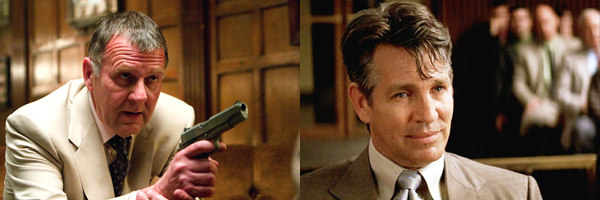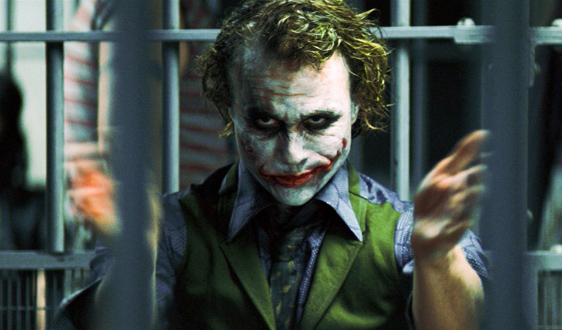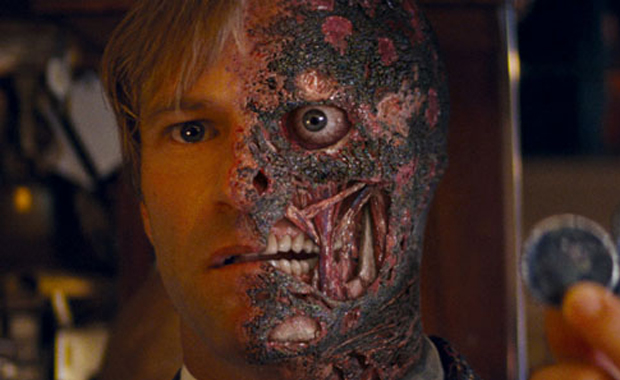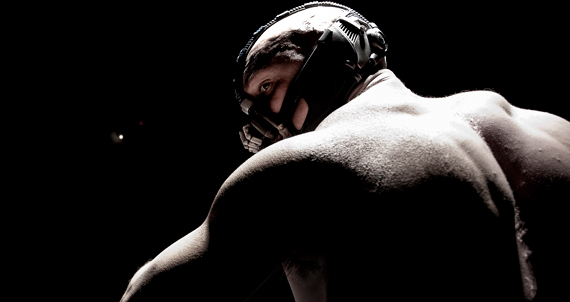What makes a hero and what makes a villain are not original concepts to Christopher Nolan's "Dark Knight" trilogy. But damn, can he make them interesting. As The Dark Knight Rises looms over the world, promising an epic end to seven years of pop culture reverence, we take a look back (and a glance forward) at the main players involved in Nolan's epic and how they relate to their comic roots. At least as best as two film freaks (with limited comic knowledge) can.
We started by taking a look at the "good guys," if we can even use such black-and-white descriptor's in Nolan's Bat-verse. Now we turn to what we can safely call the antogonists of his trilogy, the ones who want to see Gotham crumble and its citizens succumb to their dark inclinations.

The Falcone/Maroni Crime Families (Tom Wilkinson/Eric Roberts)
“You see two councilmen, a union official, a couple off-duty cops, and a judge. Now, I wouldn't have a second's hesitation blowing your head off right here and right now in front of 'em. Now, that's power you can't buy. That's the power of fear.”
Gotham is a hellhole at its worst and barely limping forward at its best. Its skyscrapers and classic architecture mask a city ruled by gangsters who corrupt and control everything and everyone around them. Both Frank Miller’s Batman: Year One and Batman Begins excel at showing this element of Gotham’s society. Gangsters unofficially rule the city, having police officers, judges and politicians in their pocket and can do whatever they want before Batman takes them on. When anyone else tries, be it ordinary citizen or Harvey Dent’s predecessor, they usually ended up dead.
The gangsters have been portrayed in a number of ways in the comics, including Batman: The Long Halloween, in which the crime families were rival factions tearing the city apart. However, Nolan made them out to be more of a cartel with collective interests in stopping “The Batman” as he systematically attacks their operations. Essentially, at least in Nolan’s universe, the gangsters are a dying breed of criminal, whose broken organizations will give rise to the more colorful (and masterful) criminals of Gotham, the Joker being Nolan’s prime exhibit to this point, though you have to imagine Bane is close behind. ~Kieran

Jonathan Crane/Scarecrow (Cillian Murphy)
“Outside he was a giant. In here, only the mind can grant you power.”
One of the lesser-known rogues in Batman’s gallery, Jonathan Crane (a.k.a Scarecrow) is one of his most formidable. Given how many of the best Batman stories deal in matters of the mind, it doesn’t help (Batman, at least) that Crane is a brilliant psychologist obsessed with the nature of power bred from fear. While Crane cannot match Batman on a physical level, he employs a variety of toxins to cause hallucinogenic reactions in his victims, and wearing a decaying, creepy Scarecrow mask heightens this effect.
As fear was the big theme of Batman Begins, incorporating Scarecrow into the story made perfect sense for the Nolan reboot. While Ra’s Al Ghul teaches Bruce to confront and conquer his fears, Crane is all about exploiting them. He’s essentially a grunt, but not without enough skills to lay the foundation for the more comic-esque villains to follow in Nolan’s subsequent sequels. Never to keep out of the picture for long and always eager to cause a little trouble since taking a dose of his own toxins, we wouldn’t be surprised to see Crane reappear as Bane wages war on Gotham. ~Max
Ra's al Ghul (Liam Neeson)
“When a forest grows too wild, a purging fire is inevitable and natural. Tomorrow the world will watch in horror as its greatest city destroys itself. The movement back to harmony will be unstoppable this time.”
Between Batman fans, there is always a question of Batman’s greatest foe: The Joker or Ra’s Al Ghul. In terms of perfect opposites, it has to be Joker. In terms of personal history and eerily similar ideologies, it has to be Ra’s. As the comic version of Ra’s is nearly immortal thanks to the use of Lazarus Pits (which keep him young but drive him temporarily insane), there is a ton of history that leads him to Gotham’s doorstep, but the general aim is the same. He is driven by a need to bring ecological balance to the world, even if it means wiping out humanity to do it.
A character like Ra’s who emphasizes matters of the mind was a perfect fit for Batman Begins. Less obsessed with ecological balance as he is with the balance of justice, Ra’s acting as a mentor to a young Bruce helped bring Bruce’s transformation to Batman alive. Their relationship is arguably Bruce’s most conflicted; it’s not made easier to navigate as Ra’s is Batman’s greatest (arguably superior) intellectual match. In many ways they are the same, but Bruce consistently questions the path he walks, whereas Ra’s never bends in his ideology. With Nolan’s trilogy coming to a close and rumors of a reappearance by Ra’s in some fashion, we wouldn’t count The Demon’s Head out yet when it comes to Batman’s fate. ~Max

The Joker (Heath Ledger)
“Don’t talk like one of them. You’re not! Even if you’d like to be. To them, you’re just a freak. Like me.”
He is the Crown Prince of Crime, the Harlequin of Hate, Batman’s greatest nemesis and one of the most iconic villains of any medium, let alone comics. He’s gone through many different versions including being a maniac killer to a comic trickster, but he's always the criminal mastermind we know and love. He is the perfect balance of chaos to Batman’s order.
Nolan took a big gamble when including the character in The Dark Knight, aiming to reinvent the character in a way never before seen. Gone was the pure campiness of Cesar Romero and Jack Nicholson. Ledger’s version gave us a character who oozed dark charisma, willing to kill anyone in his path (random or otherwise) and a master manipulator using the people of Gotham to spread his chaos. In a post-9/11 world, he was as much an anarchist as he was a terrorist — not without his own ideology but certainly without mercy. ~Kieran

Harvey Dent/Two-Face (Aaron Eckhart)
“You either die a hero or you live long enough to see yourself become the villain.”
Back in the '60s, Two-Face was known for being a gimmicky villain with his crimes having a double motive. Thankfully, comic writers saw the potential in the character and rewrote him to be the tragic character we all know. Two-Face was made out to be a fallen hero who turned to villainy after personal demons built up within his mind before finally breaking after being scarred by acid. One of the definitive stories was in Jeph Loeb’s excellent graphic novel The Long Halloween, which explored Two-Face’s origins as he becomes committed to bringing down the mob but ends up loosing his sanity, ultimately becoming a figure worse than the gangsters he set out to stop.
David S. Goyer admitted that The Long Halloween was an influence on The Dark Knight and it's clear there are similarities, with the Nolan version of Harvey still starting out idealistic and determined to bring down the mob. Aaron Eckhart made Dent a more grounded character and down-played his psychological issues before he transforms into the vengeful character. He is the fallen hero that could have been Gotham’s true Knight. In the end, unlike Batman, Harvey Dent could be corrupted. ~Kieran

Bane (Tom Hardy)
“When Gotham is ashes…you have my permission to die.”
Each of Batman's rogues are often steeped in a different area of psychology over powers/abilities; each of them represents a parallel or opposition to Batman’s psyche. That being said, not many of Batman’s villains can go head-to-head with him in a fight — unless they answer to the name “Bane.”
Of all the characters to come across Nolan’s “Batman” trilogy, Bane might be one of the biggest departures from his source material. The comic Bane’s motivations against Batman stem from an interest to rule the criminal underworld of Gotham (one that mirrors his upbringing in prison) as well as confronting his own childhood nightmares, which were plagued by bats. He believes Batman to be a manifestation of his fears that he must defeat. He is as brilliant as he is massive: his mind is sharp thanks to a classical education from a Jesuit Priest (in prison) and his physicality is frightening due to a lot of hours in the gym combined with an experimental drug called Venom that gives him near-superhuman strength and stamina.
While we can’t say yet, Nolan and Hardy’s Bane looks less like a fighter looking to conquer and more a revolutionary willing to rip apart anything in his path. Obviously, Nolan's Bane will not be the size of a house and it looks like the Venom is downplayed if part of his character at all. To what degree and for what motivations Bane has been altered, we can’t say yet, but it’s a safe bet that Nolan’s Bane is as calculated as his comic origin while remaining one of Batman’s few villains who can destroy him on both a mental and physical level. ~Max